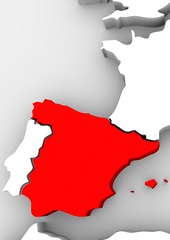Why Spain’s Economy Deserves Support
Does Spain just need a little help from its friends?
July 15, 2013

Between 1998 and 2007, Spain suffered a huge housing, real estate, construction and credit boom. The booming economy attracted a wave of five million new immigrants — 12% of the Spanish population and 14% of its work force.
Moreover, housing starts reached six million per year in 2006 (more than in the United States, which has a population that is seven times larger than Spain’s).
Real estate and construction credit was growing at 32% per year. Construction and real estate employment accounted for almost 19% of total employment. (They are now just 9%.)
In 2007, Spain’s current account deficit reached 9.6% of GDP, but the government had a fiscal surplus of 2% of GDP and its debt to GDP was only 32%. The financial crisis struck Spain a little less than other eurozone members.
However, after the bubble burst, the government’s annual fiscal revenues shrank from 5% of GDP to zero. The automatic stabilizers did the rest, bringing the public deficit to 11% in 2011.
When the Popular Party won the general elections by a large majority in November 2012, Prime Minister Rajoy thought that just by taking over the government, market confidence would be regained.
Very soon he realized that he would need to do much more than expected to bring back confidence.
The new government made an important labor reform in February 2012. This reform achieved both external flexibility and internal flexibility. The former was achieved by reducing the costs of firing, while the latter took a variety of forms.
Firms with losses were allowed to restructure their labor force, reorganize their tasks, lower their wages and reduce hours of work, in order to avoid firing or in the last instance could achieve large collective firings in order to survive.
This reform did not end the dual labor market, which was one of the causes of the large average unemployment rates in every Spanish crisis.
The older workers, with lower average productivity than the young workers, were protected by indefinite contracts and high firing costs (45 days per year of service).
Meanwhile, the young, with temporary contracts up to three years, could be fired with low costs, accumulating severance at a rate of one day per six months of service.
It is no surprise then that 85% of the employment created during the bubble and 85% of the employment destroyed during the bust were temporary workers.
Currently, the Spanish government is thinking hard about reducing the dual labor market. The best way to get there is to move towards only one single labor contract (full time or part time) with a maximum of 22 days per year of service.
That way, the country can avoid making the same mistakes when the economy starts to grow again and to create net employment.
The government has also decided to make the Spanish pension system more sustainable. A group of independent experts in pensions, chosen by the government, is proposing to adapt the age of retirement to the trends in life expectancy.
The basic reform idea is to advance the date of the legal retirement age, set today at 67 years of age by 2027, to a much earlier date, between 2014 and 2019.
The banking reform has reduced the number of banking institutions from 53 banks and 45 saving banks, that is, from 98 to only 16 banks and soon to 13 because two banks are going to be auction (excluding tiny saving banks, rural saving banks and cooperatives).
That represents the largest reduction in the number of banking institutions in the entire eurozone.
Other reform measures include:
- An annual plan to foster employment and to develop a set of active employment policies
- A law to foster entrepreneurship and internationalization
- A law to eliminate barriers to professional services activities
- A deep fiscal reform to enhance saving and investment, job creation and SMEs finance
- A reform of companies’ corporate governance and
- An energy reform
- A government fund of 40 billion euro to help households and SMEs get access to credit
Moreover, Spanish imbalances are reduced quite swiftly. The current account deficit reached -9.6% of GDP in 2007. It is now in surplus, at +1.8% of GDP as of the first quarter of 2013 and the surplus will be at 2.6% at the end of the year.
Spain’s exports have increased from 26.5% of GDP in 2004 to 32.1% of GDP in 2012 and the EU Commission expects Spain to achieve 33.7% in 2014. Exports are also becoming more diversified.
In 2004, 60% of Spain’s goods exports were directed to the eurozone. While that dropped to 49.6% in 2012, exports to Africa grew by 30.6%, to America by 14% and to Asia by 12%.
Between 2008 and 2012, Spain’s unit labor costs versus the eurozone have fallen by 12 percentage points. Real wages have fallen by 8.2 percentage points.
While that is a steep and painful decline, the good news is that productivity per person employed has increased by 12.3%.
Private debt has fallen from 144% of GDP in 2009 to 131% in 2012, or by 13 percentage points in three years. Household debt in Spain has decreased from 86% of GDP in 2009 to 80% in 2012, only six percentage points in three years.
By contrast, general government debt has increased from 60% of GDP, in 2010 to 91% of GDP in 2012.
Finally, the number of registered unemployed has started to fall for the first time in the first quarter of 2013 by 98,200 and social security affiliation has increased by 134,600. That is the largest increase since 2007.
Spain is doing what is necessary to recover from the crisis. This is the reason why the European Commission has given it more time, up to 2016, to meet the fiscal deficit target of 3% of GDP in exchange for more reforms.
I expect positive but small growth in 2014 and after the labor reforms, net employment will be created at around 1% growth rates, less than half than before.
Negative flows (fiscal and current account deficits) are being reduced quite quickly but negative stocks (debt and unemployment) will take much more time to achieve normal levels.
Read Guillermo de la Dehesa’s part twoComparing Spain and France: 10 Points.
Takeaways
In Spain, housing starts reached six million a year in 2006 (more than in the more populous United States).
85% of pre-crash employment and 85% of the employment destroyed in the bust were temporary workers.
The Rajoy government made a key labor reform for both external and internal flexibility.
Spain's banking reform is the largest cut in the number of banks in the entire eurozone.
Read previous

Prisoners of English
July 14, 2013
